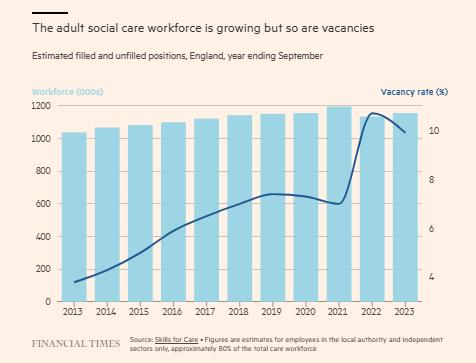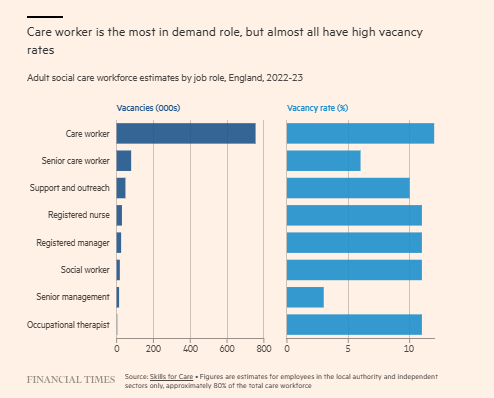the health strategist – knowledge center
for fixing and digitizing health care
Joaquim Cardoso MSc.
Servant Leader,
Chief Research & Strategy Officer (CRSO),
Editor in Chief and Senior Advisor
January 21, 2024
This is an Executive Summary of the article “Care conundrum: demographic shifts create jobs but not workers”, published by the Financial Times,, and authored by Leke Oso Alabi
What is the message?
The article sheds light on the growing challenges faced by the care sector in meeting the rising demand for healthcare-related jobs due to demographic shifts.
Despite the increasing need for care workers, various barriers, including low wages, underfunding, migration restrictions, and poor working conditions, hinder the recruitment and retention of personnel.
The article explores the impact of these challenges on the industry and examines potential solutions.
Examples and Statistics
- The World Health Organization predicts a significant increase in the number of individuals aged over 60, reaching 1.4 billion by 2030.
- McKinsey estimates a global need for 85 million healthcare-related roles by 2030, an increase of 50 million from 2016.
- In England, vacant care posts rose by 52% in 2021–2022, and similar challenges are reported in countries like Japan, Germany, France, and Denmark.
- Robotic solutions, while introduced to alleviate labor shortages, have proven costly, requiring constant maintenance and potentially worsening structural issues such as working conditions and remuneration.
- The article highlights the inadequacy of care worker pay, often at or slightly above minimum wage, making it challenging for individuals to cover basic living expenses.
Conclusions and Recommendations
- The article emphasizes the need for higher wages for care workers as a fundamental solution to the shortage.
- The structural issues in the industry, such as low pay and inadequate funding, must be addressed to attract and retain skilled workers.
- The current funding levels in the care sector, particularly in the UK, are deemed woefully inadequate, hindering the implementation of higher wages.
- The impact of immigration restrictions on recruitment and the potential consequences of banning migrant care staff from bringing their families to the UK are highlighted as additional challenges.
To summarize:
The care sector faces a critical conundrum as demographic shifts lead to a surge in demand for healthcare-related jobs.
However, the industry is grappling with significant challenges, including low wages, underfunding, migration restrictions, and poor working conditions.
Despite technological innovations such as robots, the shortage of care workers persists.
The article suggests that a fundamental solution lies in paying care workers more, addressing structural issues in the industry, and providing adequate funding.
The reliance on overseas recruitment is hindered by sponsorship restrictions and immigration policies, further complicating the situation.
To ensure the availability of a skilled workforce in the care sector, comprehensive and strategic interventions are necessary.
Infographic














